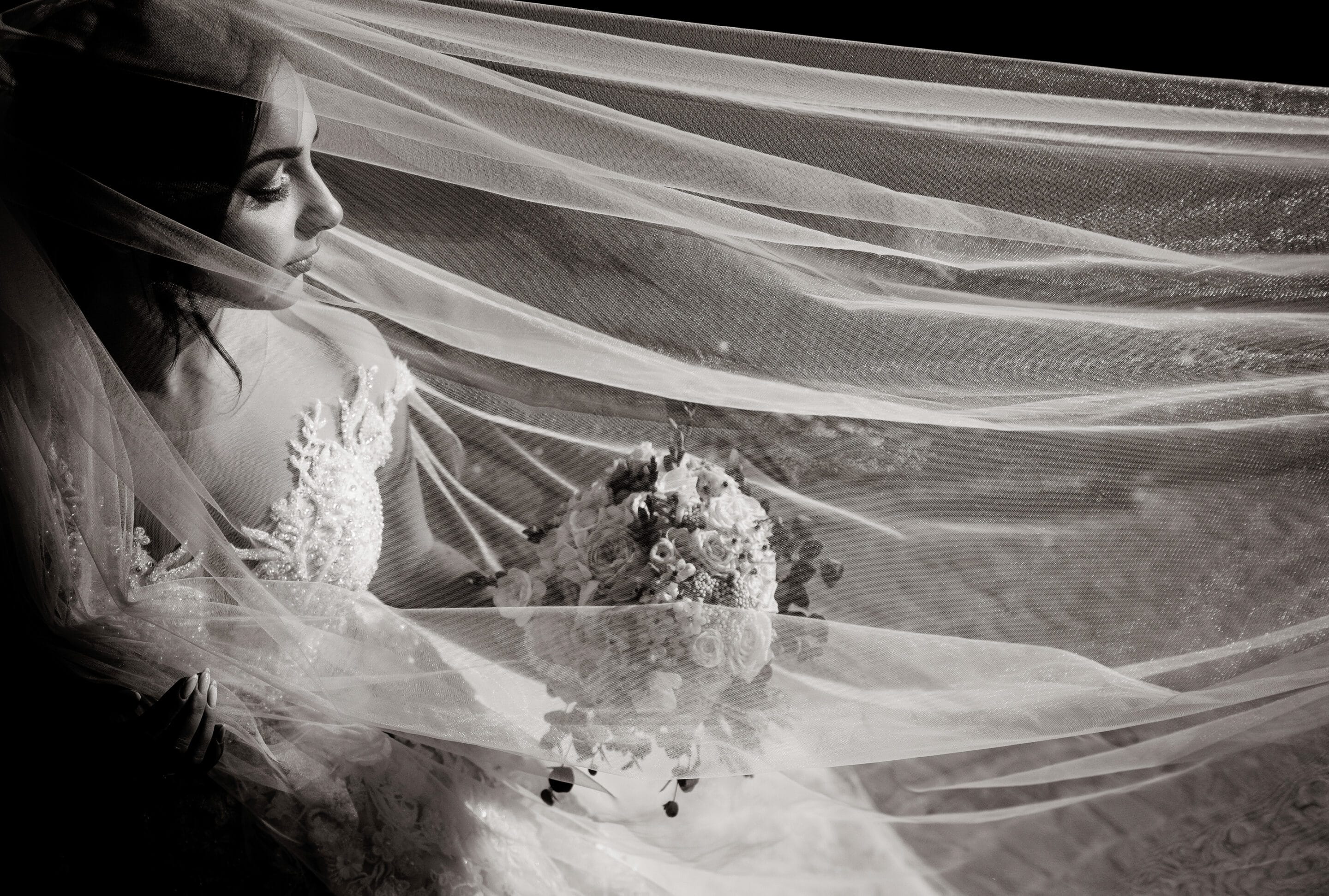Removing creases from your wedding veil is essential for that flawless bridal look—especially when you’re getting ready in a city like Chicago, where humidity and transportation can easily wrinkle delicate fabrics. The safest and most effective method is to gently steam the veil, either by using a handheld steamer or hanging it in a steamy bathroom.
Hang the veil on a padded hanger, ensuring it drapes freely without folds. Then, either lightly steam from a distance or let it sit in the steamy room for about 20–30 minutes.
For stubborn wrinkles, place a clean, white cotton towel over the veil and gently use a low-heat iron, pressing only for a second or two at a time—though this should only be done on veils without beading or lace.
Understand the Fabric First
Before attempting to remove creases, it’s essential to identify what your veil is made of. Different fabrics react differently to heat, moisture, and handling. Chicago’s humid summers and dry winters can also affect how these materials behave, so knowing the veil’s composition helps you choose the safest method.
Common Wedding Veil Fabrics
-
Tulle: Lightweight and airy, but melts easily under high heat.
-
Organza: Stiffer and can handle light pressing, but needs a barrier cloth.
-
Chiffon: Delicate and prone to wrinkles—responds better to steam.
-
Lace: Often layered on top of another fabric; needs extreme care to avoid fraying.
Why It Matters?
Understanding the fabric helps you decide whether to steam, press, or call a professional. It also ensures you don’t damage heirloom pieces or distort the veil’s shape. Always check the care tag or ask your bridal shop for fabric details if you’re unsure.
Hang It Up and Let Gravity Help
One of the safest ways to remove creases is by letting the veil hang for 24–48 hours.
- Use a padded hanger
- Hang in a steamy bathroom or near a window (not direct sunlight)
- Let gravity pull out the folds gradually
- Garment Steamer
Start by hanging the veil on a padded or fabric hanger in an open space where it can hang freely without touching the floor. Fill the steamer with distilled water to prevent mineral stains, and wait until it produces a steady stream of steam.
Hold the steamer at least 6–8 inches away from the veil and move it slowly in downward strokes. A garment steamer is a safe, effective tool for removing creases when used with caution:
- Hold the steamer at least 6 inches away from the fabric
- Move it slowly in a downward motion
- Never let water drip directly on the veil
- Steam in sections, starting from the top down
Shower Steam Trick
If you don’t have access to a garment steamer, the shower steam method is a gentle and effective alternative—especially for last-minute fixes in your Chicago hotel room.
Hang your wedding veil on a padded hanger, then place it on the back of the bathroom door or a towel hook away from direct water. Run a hot shower for 15–20 minutes with the door closed to allow steam to fill the room.
The warm moisture will help relax the fibers and gradually release creases without direct contact. Try the classic shower steam method:
- Hang the veil in the bathroom while running a hot shower
- Keep the veil far from water splashes
- Close the door and let it steam for 20–30 minutes
- Smooth creases with clean hands (no lotion or oils)
Pressing Cloth for Ironing
If steaming doesn’t entirely remove the wrinkles, ironing with a pressing cloth is a careful alternative—but it must be done with extreme caution. Lay the veil flat on an ironing board and place a clean, white cotton cloth (like a pillowcase or handkerchief) over the section you want to press.
Set your iron to the lowest possible heat setting, with steam turned off. Lightly press for just 1–2 seconds at a time—do not slide the iron, as this can stretch or burn delicate fabric like tulle or lace.
- Place a pressing cloth or pillowcase between the veil and the iron
- Set to lowest heat/no steam
- Gently press—not glide—over the fabric
- Avoid any areas with embellishments or beading
Visit a Professional Gown Cleaner
If you’re nervous about DIY methods, professional veil pressing services in Chicago can help. Many bridal cleaners offer pre-wedding gown pressing that includes your veil. They use specialized tools to gently remove creases without damaging the delicate fabric.
Portable Travel Steamer in Chicago Hotels
If you’re staying at a hotel in Chicago, many offer in-room garment steamers or pressing services. A portable steamer can be a great travel companion for destination weddings.
- Choose a compact steamer with low heat settings
- Always test steam on a corner of the veil first
- Let the veil hang near the bathroom afterward to cool evenly
Ask Bridal Boutique
Many Chicago bridal boutiques offer complimentary or low-cost wrinkle care as part of their pre-wedding services. If you purchased your wedding veil locally, call ahead and ask if they provide veil steaming, pressing, or same-day touch-ups. These professionals are familiar with delicate bridal fabrics and know precisely how to handle lace, tulle, and organza without causing damage.
- Inquire about day-before steaming appointments.
- Ask if they offer pressing of veils, trains, or capes
- Some boutiques provide delivery + steaming packages
Mistakes to Avoid
Removing creases from a wedding veil might seem simple, but a single misstep can cause lasting damage.
It’s essential to handle the fabric with patience and the right tools. Brides in Chicago often contend with weather-related humidity or dry indoor heat, both of which can make caring for their veils a challenge. Here are a few critical mistakes to steer clear of:
1. Using High Heat
Avoid turning up the heat on your iron or steamer—delicate fabrics like tulle and lace can melt, scorch, or stretch under high temperatures.
2. Ironing Without a Barrier
Direct ironing on your veil is never recommended. Always use a pressing cloth or have it professionally steamed to prevent burns or shine spots.
3. Rushing the Process
Trying to rush the process can result in snags or unraveling the process. Take your time and work gently, especially when working with detailed embroidery or beadwork.
4. Not Testing First
Always test your method on a hidden corner or edge before committing to the whole veil. Every fabric reacts differently, and you don’t want surprises on your wedding day.
When You Should Call a Specialist?
If your veil is vintage, heavily embellished, or made from ultra-delicate fabric, such as silk tulle, it’s best to leave the crease removal to a professional. Chicago has several bridal cleaning and preservation experts who understand how to treat luxury textiles safely and effectively. You should also call a specialist if:
- DIY methods haven’t worked, and the wrinkles remain.
- Your veil has lace, pearls, crystals, or fragile stitching.
- You’re short on time and can’t risk a mistake before the ceremony.
A specialist will use low-moisture steaming techniques and controlled environments to smooth out your veil without causing any damage. It’s worth the peace of mind—especially for heirloom pieces or once-in-a-lifetime events.
Steaming vs. Pressing
When it comes to removing creases, understanding the difference between steaming and pressing is key. Steaming is typically the safer method—it relaxes fibers using moisture without direct contact, making it ideal for delicate materials like tulle or lace. You can hang the veil and gently steam from a distance to avoid melting or distortion.
Pressing, on the other hand, involves applying direct (but protected) heat using a pressing cloth and an iron. This method can work well for structured fabrics or heavier creases, but must be done with extreme care.
Pressing is riskier for lightweight or layered veils, as heat and pressure can flatten the texture or damage the embellishments.
- Tulle and chiffon: Steaming is safest
- Lace or beaded edges: Use pressing with a barrier cloth
- Organza or satin-edged: Use extreme caution, test heat levels

Preventing Future Creases
Keep your veil smooth after pressing by:
- Storing it in a long garment bag
- Avoiding folding or placing weight on it
- Hanging it until the final moment before wearing
Information You May Also Like:
- Wedding Dress Cleaning and Preservation
- Emergency Gown Cleaning in Chicago
- Pre-Wedding Gown Pressing Service in Chicago
Recommended Steaming Techniques for Delicate Fabrics
Learn more from Martha Stewart Weddings.
FAQs
How far in advance should I steam my wedding veil?
At least 1–2 days before your event to give it time to hang and settle.
Is ironing safe for a wedding veil?
Only with a pressing cloth, very low heat, and no steam. Steaming is much safer.
Can dry cleaners remove creases from veils?
Yes, especially those specializing in bridal gowns and veils.
Will a veil crease if packed in a suitcase?
Yes, folding a veil can cause sharp creases. Always hang it or roll loosely.
What’s the fastest way to unwrinkle a veil?
Use a garment steamer or the shower steam method for quick, gentle results.
Can I steam my veil while wearing it?
No. Always steam it off the headpiece to avoid injury or fabric damage.
What should I avoid when steaming a veil?
Avoid direct water contact, too much heat, and pulling on the fabric.
Do I need a professional cleaner for just a veil?
Not always, but professionals ensure safety and flawless results—especially in high-pressure situations.
What’s the best way to store a veil wrinkle-free?
Hang it in a long garment bag or acid-free box with tissue layers.
Can I use a hair straightener on a veil?
Not. Hair tools can be too hot and melt or damage delicate fabrics.





